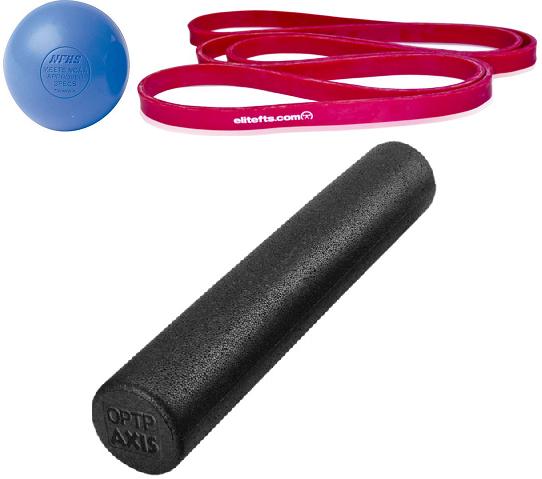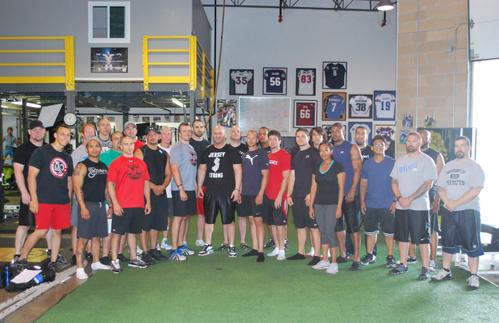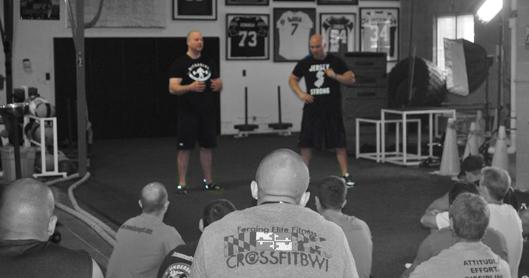If You Fail to Prepare, You Prepare to Fail…Warming Up Explained
Smitty commented that 95% of the questions he saw on EliteFTS related to pain. As he dug a bit deeper, he and Joe realized that weaknesses and mobility were topics that received lots of hits. The two of them decided to fill this gap by creating the AMPED Warm-Up system. I have the AMPED system and I highly recommend it whether you train athletes, general population or you train alone and want to feel and perform better.
There are 4 parts to a proper warm-up:
1) Soft Tissue Work – use a foam roller and / or a lacrosse ball to massage and loosen up the muscles
2) Mobility Work – consists of various movements to loosen up the muscles and ensure flexibility through a full range of motion
3) Central Nervous System (CNS) Activation – priming the body and gearing it up to be ready for the work ahead. This essentially wakes the body up and gets you ready to lift.
4) Muscle Activation – warming up of the muscles which will be worked that day so they are ready for the session of work ahead
The order is not set in stone and it can be blended. If in the midst of training, the individual does not feel 100%, they can continue to incorporate these techniques in between sets or in between exercises. Doing some foam rolling and mobility work between exercises can serve to loosen up muscles that are really tight and will improve performance and recovery.
Joe and Smitty both use auto-regulation to determine the status of their clients. Auto-regulation can be described simply as “how do you feel?” and it is a matter of determining how the body is responding to stimuli. If after a full warm-up, the client still seems like they are not at 100% or that they are overtrained from a previous session, Joe and Smitty would rather send someone home than push them when their body is not ready. Some telltale signs of overtraining are red palms, a feeling that the weights are cold to the touch and an elevated resting heart beat (i.e. heart is beating fast when you are not doing anything). It is better to be safe than sorry and you will be better served in the long-run by listening to your body when it is not ready to train.
Morning Session of the Seminar
Smitty started out by having us put one hand on our chest and the other on our stomach and telling us to breathe. Most people, including me, have their chest rise when they breathe. Smitty stressed diaphragmatic breathing (breathing from the stomach, not the chest) because it stabilizes the core, promotes good posture and is more efficient.
After this, we got down to business and did soft tissue work by rolling with a foam roller and lacrosse balls. We split into groups of 2 and I had the good fortune of having the lacrosse balls in my hands to start off with and I was seeing stars as I lay on top of them and rolled them up and down my spine. The best way to describe how this feels is to imagine a circus clown pedaling a unicycle back and forth on your spine!!! We started with the upper body going through the thoracic spine, upper back, lats and shoulders. The upper body warm-up concluded with Face pulls, Lat & Shoulder stretches with bands and several variations of the Roll Over and Stretch.
After the upper body was ready to rock, we foam rolled the lower body, including the piriformis, glutes, quads, IT bands and hamstrings. Joe DeFranco showed us how he uses the lacrosse ball to loosen up the Achilles and the calves. He also had us lie face down with the lacrosse ball above our knee on our quad and we flexed the knee; this really loosened up the quad. The lower body warm-up concluded with loosening up the hips. We hooked a band up to the squat rack and put our leg through it so the band was near the top of our leg and then got on all fours facing away from the rack and flexed & extended the hip (backwards & forwards) and then we adducted & abducted the hip (side to side). This did an incredible job loosening up the hips.
Worth the Price of Admission #1
In the midst of Foam rolling, Smitty said that when you reach a tough spot, stay on it and move your limbs. So, when rolling on your back, find a tough spot, stop on it and move each arm in a sweeping motion overhead then, move both arms overhead and back to the sides. This really helps with hard to reach areas around the shoulder blades where knots tend to form.
Worth the Price of Admission #2
Move that saved Joe DeFranco’s shoulder: Lie on your side, have your shoulder tucked with your upper arm (triceps) on the ground perpendicular to your body. Place a lacrosse ball under your armpit, flex your lower arm at the elbow until your forearm is perpendicular to the ground and slowly push your hand down to the ground, stop and hold for a count of 3 to 5, push further and hold for a count of 3 to 5 and continue until your palm is flat on the ground. Do both shoulders. Be careful and move SLOWLY since you are in a very vulnerable position here. These small muscles (Infraspinatus, Supraspinatus, Teres minor, etc.) tighten up very easily so, this exercise will work wonders in loosening up the shoulders.
Worth the Price of Admission #3
I had the chance during breaks to pull Smitty and Joe D aside separately and ask them about 2 issues:
1) Tight Hamstrings – I can stretch all I want to, but I can never touch my toes. I have legs that are longer than my torso so, that makes it a little more difficult, but I can even remember not being able to touch my toes when I was very young.
Smitty – “It isn’t your hamstrings; you have tight hips, guaranteed. Loosen up your hip flexors and you will get more mobility. Your hamstrings are tight as a compensation for your hips.”
Joe D. – “We have tons of athletes with tight hamstrings and knock on wood we haven’t had any hamstring pulls. The key is loosening up the hips and the glutes. When those 2 areas are locked up then, your range of motion will be compromised. Loosen them up and you will be fine.”
2) Patellar Tendonitis in my right knee – I had a chance to ask Smitty about this and it came back to the hips. Tight hips and the associated lack of range of motion are resulting in pressure being placed on the patella.
There is a very interesting takeaway here…the area where you are having an issue is where the problem is being REALIZED, but typically the issue ORIGINATES elsewhere. The body compensates for our weaknesses in areas other than where the problem is so, treating the symptom (tight hamstrings) is not going to address the problem (tight hips / glutes).
Afternoon Session of the Seminar
After eating some great food from Muscle Maker Grille, we were ready for the afternoon portion which consisted of Mobility & Activation. Joe DeFranco led us through this portion and we did Jumping Jacks, Seal Jacks, Cossack Squats, Bodyweight Squats and Lunges (forward & backward), Wideouts, Sprinting in place, Skips, Side Shuffles and Hip Rotator Skips (skipped backwards by externally rotating one hip at a time). After this, we were ready to train!!!
We broke up into groups where we went to one of five stations:
1) Box Squat – push hips and glutes back, push knees out to the side NOT forward, touch the box and explode upward.
2) 400LB Tire Flip – get in a deadlift position with hands under the tire, lift the tire up with hands underneath and once you get it to 45 degrees, kick it up with your knee and push forward with your hands until the tire hits the ground. You can turn it into a complex by jumping onto the tire or jumping into the tire and through. If you have a sledgehammer, you can hammer the tire after flipping it.
3) Box Jump – this was the station that Joe DeFranco was at. There was a 36 inch box set up but it had padding to prevent injury. The first round, we squatted down and used our arms to explode upward and land softly on the box. The second round, we held two 10LB dumbbells and jumped upward and upon landing, dropped the dumbbells and jumped up again. Joe explained that your brain and motor neurons still think you are holding the dumbbells after you have dropped them so, more muscle is recruited and you jump higher.
4) 25 LB Med Ball Throw – this happened on the turf. We squatted down while holding the med ball and exploded upward with the legs and arms and launched the ball as far as we could.
5) Prowler loaded with 90 LBS – there was a rope attached to the Prowler and we pulled it 50 feet towards us and once it got to us, we grabbed the handles and pushed it 50 feet back to the starting position.
Joe and Smitty finished up with a Q&A which was really helpful.
Q: “What do you recommend for recovery the night of the workout and the next day if it is an off day?”
Smitty: “Get some rest and some food after the workout. We have our athletes do foam rolling the night of the workout and then on the day off they come in, do the full warm-up and go home.”
Joe: “After the workout we make sure our guys get some food in their body. That night, we have our athletes do mobility work and take an ice bath for soreness. We have 2 or 3 warm-up sheets posted on any given day and the athletes take a picture of it on their phone and do the mobility portion.”
Q: “How can you tell if someone is overtrained and their nervous system is fried?”
Joe: “Watch the warm up and you can tell how they are feeling. I have found that the best way to tell is the vertical jump. If a guy is a 31 inch vertical jumper and he does 26 then, he is off and I will have him go home and come back the next day when he has recovered.”
Smitty: “Red hands are a big indicator for me. That is something I have noticed over the years. A high resting heart rate and the weights feeling cold to the touch are also indications that they are fatigued.
Q: “Do either of you use PNF (Proprioceptive Neuromuscular Facilitation) Stretching?”
Smitty: “We use it sparingly.”
Joe: “We use it when needed. If I am working with some NFL guys and I can tell that they are tight, I will do some PNF stretching on them myself.”
Q: “What do you guys use to evaluate new clients?”
BOTH: “A bodyweight squat is a great exercise which will tell you a lot. Does the back round? Do the knees collapse? Are the heels coming up? Have them perform a push-up, do their hips sag? Other good exercises to assess with are the plank and the overhead reach. Mix it up, do static positions and dynamic movements, try the same exercise loaded versus unloaded. Sometimes imbalances show up when an exercise is loaded, but not unloaded and vice-versa.”
Joe: “Sprinting is a great assessment. By watching someone move you can see many different things, including whether their hip flexors are tight.”
Q: “What do you do when you see asymmetry in an athlete? How do you develop a program for them?”
Joe: “I have always found that the best method is to create a balanced program. Whatever the person normally does (e.g. offensive lineman = pushing), train them to do the opposite (e.g. rows, pulls, etc.). A Balanced athlete is going to last longer, perform better and have fewer injuries.”
Joe then mentioned that the next product he and Smitty are coming out with is about developing power for athletes. Power is strength x speed so, the more powerful you are, the more athletic you will be. To this end, Joe said that if he could go back and do something over again, he would have incorporated med balls much sooner. Whether it is throwing, chest passing or overhead tosses, med ball work is most transferable to athletics because there is no deceleration, there is acceleration and power throughout the entire movement. Joe mentioned an All-Pro offensive lineman who plays for the NY Giants which he trains and how he brought in one of their new rookies who is a huge offensive lineman. Both guys had a similar huge bench, but the difference maker was in their power. The veteran can launch the med ball, but the rookie cannot. It goes to show that barbell exercises are not the be-all end-all and a power movement like a med ball throw is more transferable to the field than a big squat or big bench.
So, there you have it! The inaugural AMPED Seminar was a MASSIVE success and I learned a ton of stuff that will help me and the people I train. Joe DeFranco and Smitty are not just at the top of their game, but both of these guys are gentlemen who were humble and more than happy to answer any and all questions. I would highly recommend checking out the next AMPED Seminar and learning how you can improve your results and the results of those whom you train. Reading and seeing how to do the warm-ups is not the same as doing them, especially when you are learning from the best!!! Thanks Joe and Smitty!!!
To see Joe DeFranco’s gym: click here
To see Smitty and the Diesel Crew: click here
To check out the AMPED Warm-Up System: click here
Did you enjoy this post? Buy me a cup of coffee ![]()








Awesome write-up brother, thanks for coming!
Smitty
[...] To gain strength fast, you need to immediately begin amping up your strength thermostat in your mind… have many kinds of thermostats that limit our abilities in a myriad of ways. Your body is surely capable of expressing much greater strength than you already are. It's your mind that's holding you back. Since your muscles can't think on their own, it's up to you to shift your thought patterns to begin channeling new and powerful energies throughout your body – into every cell, into every muscle fiber. It's not a new training regime that you need. It's not new equipment that you need. It's not a new diet that you need to gain strength. It's not a new supplement that you need to gain strength. [...]